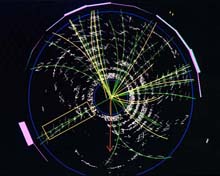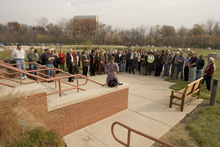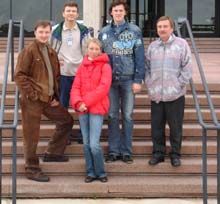 | Wednesday, November 9, 2005 |
|
Wednesday, November 9 11:00 p.m. Research Techniques Seminar - 1 West Speaker: V. Buzuloiu, Universitatea Politehnica, Bucharest Title: Research in Signal Processing at LAPI 3:30 p.m. Director's Coffee Break - 2nd Flr X-Over 4:00 p.m. Fermilab Colloquium - 1 West Speaker: E. Adelberger, University of Washington Title: Sub-Millimeter Tests of the Newtonian Inverse Square Law Note: There will be no Fermilab ILC R&D Meeting Today
Thursday, November 10 |
|
Extended Forecast |
Secon Level 3 |
|
Wednesday, November 9 - Fish & Chips - Smart Cuisine Salmon w/Lemon Pepper - Country Fried Steak w/Pepper Gravy - Beef & Cheddar Panini w/Sauteed Onions - Assorted Personal Size Pizzas - Meatlover's Pizza - Cavatappi Pasta w/Italian Sausage & Tomato Ragu The Wilson Hall Cafe accepts Visa, Master Card, Discover and American Express at Cash Register #1. |
|
Wednesday, November 9
Chez Leon Menu |
| Fermilab Today is online at: http://www.fnal.gov/today/ Send comments and suggestions to today@fnal.gov Fermilab Today archive Hurricane Relief Page Fermilab Today PDF Version Fermilab Result of the Week archive Fermilab Safety Tip of the Week archive Linear Collider News archive Fermilab Today classifieds Subscribe/Unsubscribe to |
| Crash Course in Luminosity, Key to Discovery at Fermilab |
| This is the second story in a series that explains what luminosity is, and why we've recently gotten better at producing it in the Tevatron. This article explains why high luminosity, which provides a greater chance for collisions in the Tevatron, matters to anyone who is curious about the universe. |
|
Why do we care about increasing our chances for collisions? In the Tevatron, collisions can form exotic new particles that may help physicists discover the universe's best-kept secrets. When a proton and antiproton collide almost at the speed of light, they create an enormous burst of energy. Following Einstein's famous equation, E=mc2, some of this energy can convert to brand new particles. "Imagine a car crash," said Steve Holmes, Associate Director for Accelerators. "Two Minis run into each other and, instead of a fender rattling to the pavement, a 1997 Hummer pops out." The energy can take the form of huge chunks of matter that belong in another era. Some of these massive particles may give us clues about the evolution of our universe. "One could almost say that we are bringing extinct states of matter back into existence," said Roger Dixon, who manages the Accelerator Division. Billions of years ago, the universe was denser, hotter and packed with energy, so the particles made in high-energy colliders may have been as common and natural then as carbon is today. Physicists can study the tracks left by these fleeting particles in the Tevatron detectors to learn about the primitive environment they once thrived in. The more energy created by the proton-antiproton collisions, the more ancient the resulting matter. "The energy in the Tevatron is two TeV," said Pushpa Bhat, who manages the run II upgrades of the Tevatron. "That matches the universe's energy one picosecond after the big bang." |
|
From EurekAlert, November 8, 2005: What does 'almost nothing' weigh? FSU physicist aims to find out TALLAHASSEE, Fla.-- If subatomic particles had personalities, neutrinos would be the ultimate wallflowers. One of the most basic particles of matter in the universe, they've been around for 14 billion years and permeate every inch of space, but they're so inconceivably tiny that they've been called "almost nothing" and pass straight through things -- for example, the Earth -- without a bump. So it's easy to see why no one thought they existed until the 1930s, and why it wasn't until the 1950s that scientists were finally able to confirm their inconspicuous presence. It's also easy to see why their masses, once believed to be zero, remain so elusive, but could help unlock the universe's mysteries on everything from dark matter to the births of galaxies. With a Precision Measurement Grant from the National Institute of Standards and Technology that will provide up to $150,000 in funding over three years, Florida State University research physicist Edmund G. Myers, in Tallahassee, Fla., and student researchers hope to meet part of that challenge by measuring the precise difference in mass of tritium, a form of hydrogen, and helium-3 atoms. This will help pin down the mass of the electron neutrino. To make such a measurement, Myers will use the state-of-the-art Penning trap that he brought to FSU from the Massachusetts Institute of Technology in 2003. It's arguably the most precise equipment made for the purpose of determining atomic mass. "With neutrino mass, the game is to keep lowering the upper limit until you find it," Myers said.
Right now, that ceiling is around 2 electron Volts (eV). Myers' work, combined with results from other experiments, could drop this by a factor of at least 10, to 0.2 eV or even lower. By comparison, an electron, which is probably the lightest commonly known subatomic particle, has a mass of 511,000 eV.
|
| NALWO Dedicates Bench in Memory of Sue Mendelsohn | ||
|
Yesterday at 1:00 p.m. in front of the Lederman Science Center, NALWO dedicated a special teak and oak bench to the memory of Sue Mendelsohn. Mendelsohn was an employee of the Lederman Center and a longtime secretary of NALWO, Fermilab's women's organization.
The bench was handcrafted by Sue's husband, Michael Church. "This bench will a place for me to remember Sue," he said. "And for others to remember her too." Friends of Mendelsohn gave testimonials that described her as energetic, caring, optimistic and funny. Long-time friend, Marjory Appel remembered sharing time with Sue and her grandchildren at the Fermilab pool. "After we went swimming, she used to dress the kids by putting underwear on their shoulders and socks on their ears," she said. Mendelsohn, who passed away on November 12 last year, was also a nature-lover and an activist. "Sue didn't just complain about how things were, she really worked hard to make them better, that's why her legacy is so important to carry on," said Mady Newfield of NALWO. "She'd want this bench to remind us of that."
If you would like to make a donation contributions towards the cost of the bench materials and the commemorative plaque, contact Mady Newfield, NALWO's treasurer at 584-0825 or mady.newfield@gmail.com.
|
|
Payday Change Due to the upcoming Veteran's Day on Friday November 11, 2005 and the fact that most banks will be closed, employees will paid on Thursday, November 10, 2005. Advices will also be distributed on Thursday.
Give the Gift of Good Health
Entertainment Books are On Sale
|


